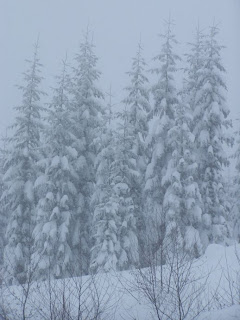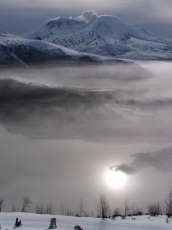I come at the question from a unique perspective that has fallen on deaf local ears thus far. I have worked 11 summers with the National Park Service. I understand the management culture, and the mindset of the employees themselves. It is an organization that is extremely bureaucratic, but from top to bottom, the service works for the same mission.

Some more photos will be included as time is available... Minnie Peak and Coldwater Peak is classic world class scenery especially in the winter.
In 2004, I came to work for the Forest Service at Coldwater Ridge Visitor Center and Johnston Ridge Observatory at Mount St. Helens. For more than three years, I worked as part of a supervisory team that covered the Monument on the north side of the volcano. Our philosophy was to treat visitors with a very Park Service-like model. It was very successful and despite the Forest Service uniforms, our visitors assumed that Mount St. Helens was a National Park. Like myself, most of our employees had worked in the National Park Service culture and embraced its values.
The problem at Mount St. Helens is that there is a disconnect between the staff on the ground in front of visitors and those that administer the monument from the national and regional level. The Forest Service is torn between its mission of multiple use and this Monument does not fit the standard operating procedure including funding at national, regional and finally district levels as opposed to line item allocations for each property.

The main question should be what will the National Park do for me? It has been well established that the two agencies are heading in different directions (at least under the Bush Administration). While the Forest Service has been cut year after year, to the point of near irrelevancy, the National Park Service actually saw its budget grow this year.
Assuming all or a portion of the Monument became a National Park Service property, and it received its full funding for a resource with its size and visitation, it might be compared to Lassen National Volcanic Park in Northern California. The budget at Lassen was about $4.5 million while St. Helens featured a frugal expenditure of $500,000. During a 2005 study by the National Parks and Conservation Association, Lassen Volcanic’s budget contributed 362 jobs (Part- and fulltime including NPS employees) that generated $11,523,000 of local personal income and brought in $16,436,000 of spending by visitors from outside local areas on lodging, food, transportation, souvenirs, etc. around the park. I might add that Lassen is in a far more remote location, away from major highways and population centers than Mt. St. Helens.
 Getting to Coldwater Lake was almost impossibe during the winter of 2006-07 because the Washington Department of Transportation chose to not maintain Highway 504 past MP35.
Getting to Coldwater Lake was almost impossibe during the winter of 2006-07 because the Washington Department of Transportation chose to not maintain Highway 504 past MP35.The National Park Service is a brand name, an icon that is a draw to its own. Surveys in the 1980s found that the goals of many world travelers included “meeting a park ranger”. The U.S. National Park Service is one of the most respected agencies world-wide.
The NPS may also bring with it “exclusive jurisdiction” that would end bizarre cooperation agreements with local agencies as well as the Washington Department of Transportation. The latter is responsible for the management of Highway 504 as well as the closure thereof. Beyond its closed gates, hikers, skiers and those on snow shoes are not allowed to use the route for recreation during the winter for liability reasons. The road from Coldwater Lake to Johnston Ridge has been closed to any recreational use. The Forest Service had a very difficult time keeping access open to recreational areas on the south side of the mountain during the winter of 2006-07. Lack of access goes against the culture of the Forest Service let alone the Park Service. Of course this may be a moot point based on the fact the NPS would probably keep Johnston Ridge open through the winter. One only has to look at Paradise at Mt. Rainier or the Steel Center and Rim Village at Crater Lake National Park to see the effort presented to keep winter ecological stories available to the public.

I also believe that with the additional budget and management would see the value of reopening Coldwater Ridge Visitor Center. The resource at Coldwater Ridge tells its own stories about the recovery of the landscape after the eruption of Mount St. Helens in 1980. It is a totally different ecological location than the more popular center at Johnston Ridge. The National Park Service understands the value of interpreting differing landscapes even if the majority of the public doesn’t always see that same significance.
 Coldwater Ridge Visitor Center was kept open all winter as weather would allow. The public is very interested in the winter ecological story in the blast zone.
Coldwater Ridge Visitor Center was kept open all winter as weather would allow. The public is very interested in the winter ecological story in the blast zone.Putting trained Park Rangers in front of the public is a high priority for the Park Service. Where the Forest Service systematically cut the number of rangers at places like Ape Cave, Windy Ridge and the visitor centers and attempted to replace them with volunteers over the last three years, The NPS culture places a priority of highly trained and skilled rangers with excellent customer service skills.
Finally, the NPS, would not tolerate the condition of the trails in the Mt. Margaret Backcountry or the roads around the Monument. One of the most special wilderness areas in Southwest Washington is now all but unusable due to lack of access. With both the USFS 26 and 99 roads washed out and trails falling off the side of ridges from lack of maintenance, the Margaret Country went almost unvisited during the summer of 2008. Roads around St. Helens that were damaged during the storms of 2006 are just getting reopened, but The National Park Service worked at breakneck speeds to repair damage at Mt. Rainier. They secured nearly $30 million in emergency funds and were genuinely embarrassed that they had to shut down the park or even parts of it for any length of time.

If all or a portion of the Mount St. Helens National Volcanic Monument were transferred to the management of the National Park Service, the culture would change at both the Monument and in the communities around the mountain. Those who use national parks as playgrounds will have new life at Mt. St. Helens with modest improvement in the physical plant, and a more friendly upper management. The only problem local communities would have is how to compete with area major metropolitan areas for residual dollars.












